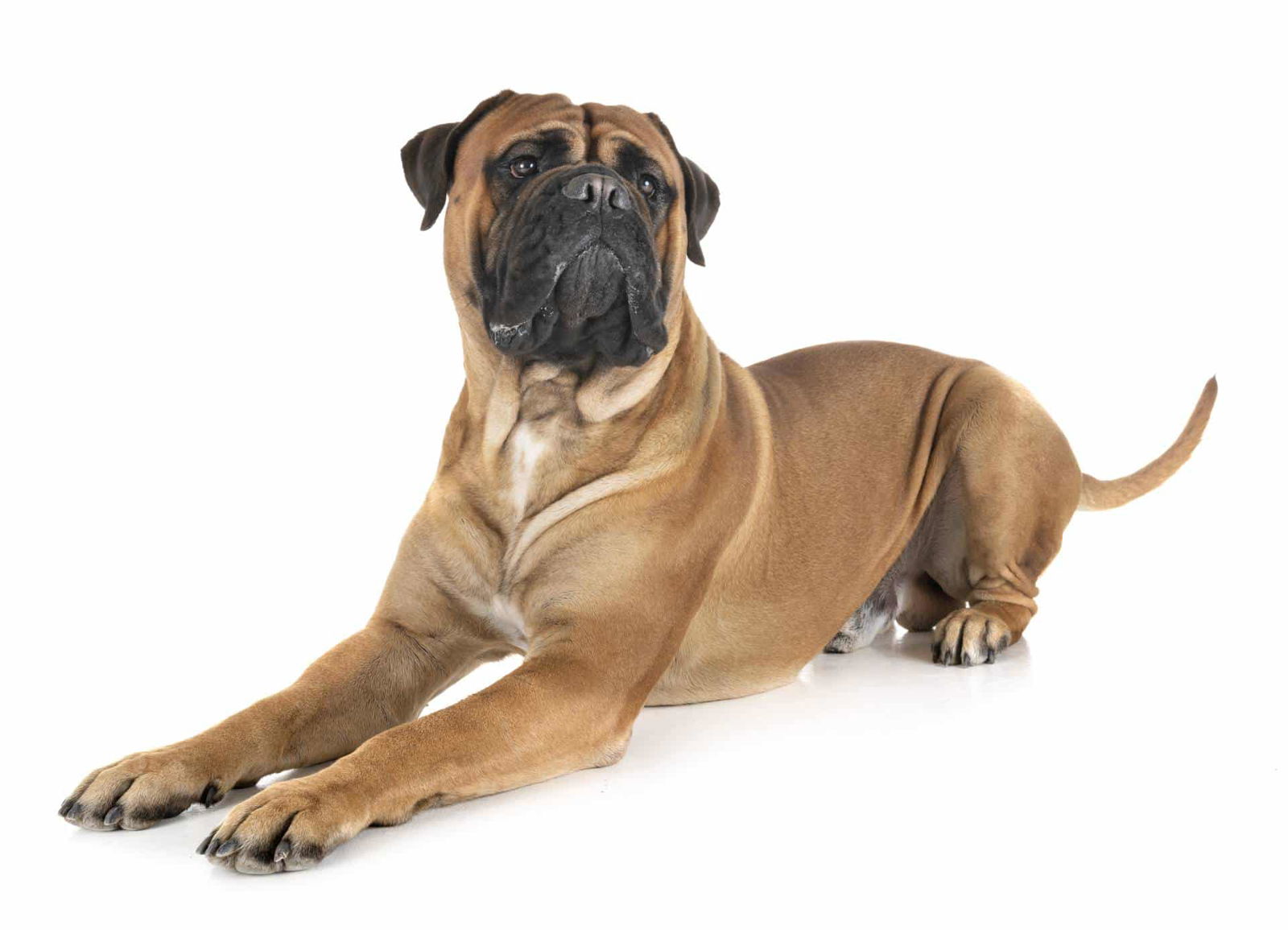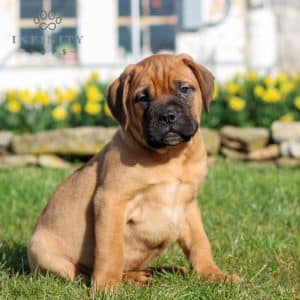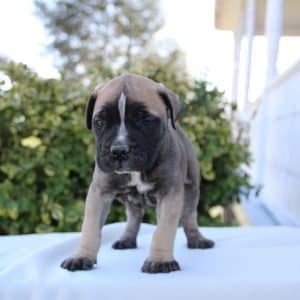Have a question about our Bullmastiff puppies?
"*" indicates required fields
overview of the Bullmastiff Dog Breed
Are you looking for an intelligent, loyal, and protective guard dog?
Check out our Bullmastiff puppies for sale below!
This large, powerful dog is loyal, brave, and alert and loves its family deeply.
They make wonderful guard dogs; Bullmastiffs were bred to protect the property of the English aristocracy and they will do the same for your home and backyard. Bullmastiffs will be aggressive towards intruders and dogs of the same sex. Early socialization and training are absolutely essential.
This breed is not recommended for first-time dog owners.
Adopt your Bullmastiff puppy today and start enjoying this brave and loyal breed!
Bullmastiff temperament
Intelligent: Bullmastiffs are smart, alert, and confident. While they are independent thinkers, they are also eager to please.
Excellent Guardians: Loyal, brave, and strong, the Bullmastiff isn’t afraid to take action when they feel their family is threatened. As with any guard dog, it’s essential to socialize your puppy at a young age so they learn what situations are normal and what is a threat. Bullmastiffs can be aggressive with other dogs of the sex, so always keep them on leash in public places, and in a fenced-in yard at home.
Quiet: Bred to catch poachers on large English estates, these dogs are silent guards and won’t bark very often.
Low Energy: Bullmastiffs have low to moderate energy levels. They make great walking partners, but should not be expected to be a running partner. When exercising them, keep them in your fenced-in yard because they are territorial and may be aggressive to anything that comes into their space.
Calm and Dependable: With proper training, Bullmastiffs are loving and sweet with their families. They are a strong and calm yet protective presence and can be excellent family dogs.
Bullmastiff Breed history
The Bullmastiff originated in mid-to-late 19th century England.
The English aristocracy had huge estates with lots of land for hunting, and poaching was a common crime on these estates. Although poaching was illegal, it was hard to control.
If caught, poachers could face the death penalty. This meant that when a poacher came face to face with a gamekeeper, they had nothing to lose. Poachers weren’t afraid to shoot it out with the gamekeeper, which would be better than going to the gallows.
Enter, the fearless Bullmastiff!
Gamekeepers began crossing Bulldogs with Mastiffs to create the perfect guard dogs.
The Mastiff was large, but not brave or aggressive enough to chase down poachers. Bulldogs were aggressive, but not large enough or athletic.
It’s important to note that the Bulldogs they used to create the Bullmastiff are not like our Bulldogs today. Bulldogs were originally used for bullbaiting and dog fighting and were bred to be aggressive and fearless. These aggressive traits have been bred out of the Bulldogs we have today.
By crossing the Bulldog with Mastiffs, gamekeepers created large, fearless dogs that were perfect for tracking down poachers. Soon, gamekeepers began holding competitions to see who had the best Bullmastiffs.
Although poaching declined, Bullmastiffs became wonderful guard dogs and joined England’s Kennel Club in 1924.
The Bullmastiff was accepted by the AKC in 1933 and ranks 56th out of breeds registered with AKC.
Bullmastiff Average size
Male Bullmastiffs measure 25-27 inches tall at the shoulder and weigh 110-130 pounds. Females measure 24-26 inches tall at the shoulder and weigh 100-120 pounds.
Average Bullmastiff lifespan
You can expect your Bullmastiff to live for 7-9 years.
Bullmastiff body features
They are a beautiful fawn or red color and can also be brindle. They have a black mask on their face.
grooming Your Bullmastiff Puppy
The Bullmastiff’s coat is short and relatively low-maintenance. They shed moderately year-round. You should brush them regularly with a rubber curry brush or a shedding blade to remove loose hair.
Bullmastiffs have wrinkles on their faces which can trap moisture and dirt. Use a warm, damp cloth to wash in between the wrinkles every day. Be sure to dry them thoroughly!
Your Bullmastiff will also need its nails trimmed and teeth brushed regularly.
Bullmastiffs drool, so you’ll want to keep some cloths nearby to wipe their mouths, your clothing, and whatever else they may drool on!
Keeping Your Bullmastiff Puppy Healthy
Not all dogs will have every health condition, but dog owners need to know what health conditions may affect their dogs.
First, a word about safety:
Safety Precautions for Bullmastiffs
Due to their short snout, the Bullmastiff can overheat quickly. Please keep a careful eye on your dog during extreme temperatures.
Since breathing is difficult for them, heavy exercise can be too strenuous for them, especially on hot days. Keep an eye on them carefully during walks and other forms of exercise to make sure they are breathing properly.
Bloat, a Life-Threatening Condition
One of the most serious health concerns for the Bullmastiff is bloat. Bloat, also called gastric dilatation-volvulus or gastric torsion, can affect any large breed dog and is a life-threatening condition.
Bloat is when the stomach becomes twisted, and the gases in the stomach are unable to escape. The pressure from these gases affects the blood flow to the heart, and it can be fatal.
To prevent bloat:
- Avoid feeding your dog right before or after heavy exercise.
- Feed them a few smaller meals a day instead of one large meal to prevent bloat.
- Learn to recognize the symptoms of bloat so you can take action immediately.
Some owners choose to have surgery done to tack their dog’s stomach in place and prevent it from twisting.
Protect Your Bullmastiff from Obesity
You can protect your dog from one of the most common health problems: obesity. One of the best ways to extend your dog’s life is by feeding them the correct amount of food and giving them adequate exercise.
Hip and Elbow Dysplasia
Like all dog breeds, the Bullmastiff is at risk for hip and elbow dysplasia, two of the most common health issues in dogs.
Hip and elbow dysplasia occurs when the thigh bone doesn’t fit snugly into the hip and can result in limping, lameness, or arthritis if it’s not addressed.
Hip and elbow dysplasia can be genetic, or it can be caused by environmental factors such as overeating or injuries.
Here are some ways to prevent hip dysplasia in your puppy:
- Ask the breeder for an OFA (Orthopedic Foundation for Animals) Hip Clearance. Dogs with hip dysplasia shouldn’t be bred.
- Talk to your vet about the right food for your puppy and stick to the correct amount to prevent unhealthy growth.
- Keep your puppy from running or jumping excessively on hard surfaces and standing on its hind legs.
Typical Bullmastiff Allergens
First of all, what causes allergies?
Allergens are caused by dander, which is dead skin cells. Both animals and humans shed these dead skin cells. Dander is attached to the fur that dogs shed.
Bullmastiffs are moderate to heavy shedders and are not considered an allergen-friendly breed. Allergens can be lowered with regular brushing and bathing.
If you or someone in your home has animal allergy concerns, please consult your health provider before adopting a puppy.























